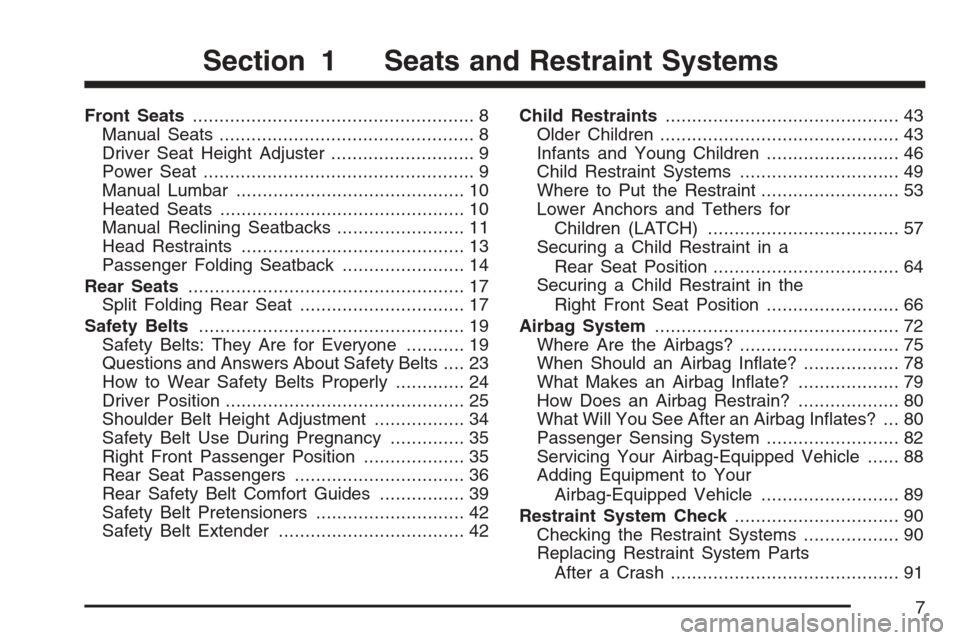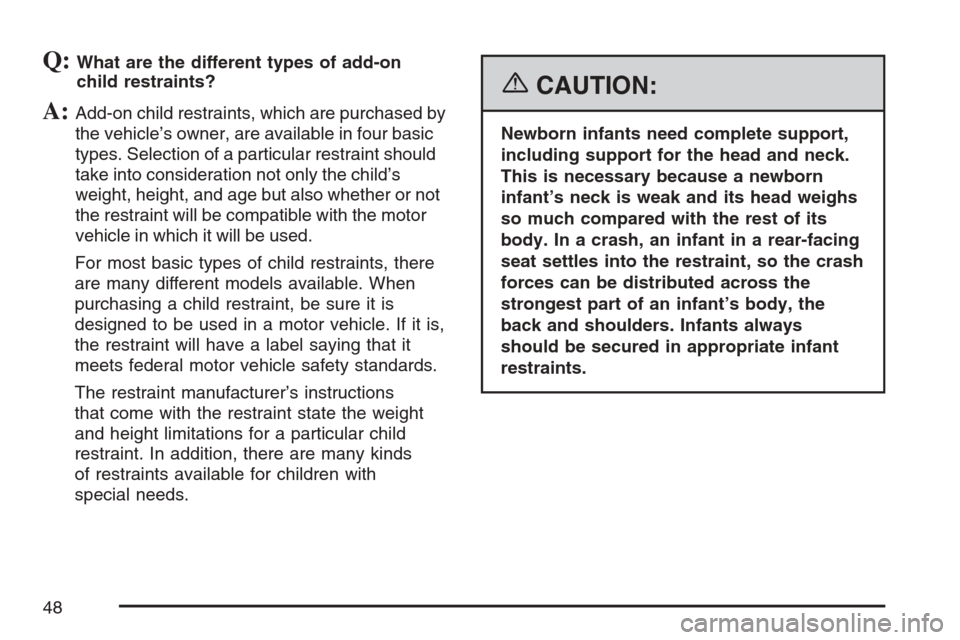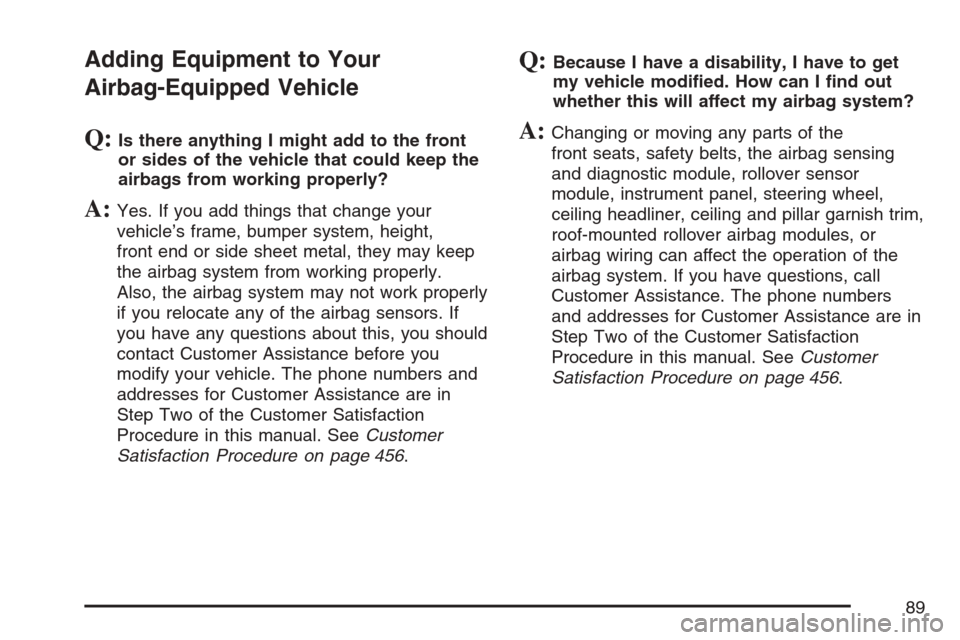Page 7 of 492

Front Seats..................................................... 8
Manual Seats................................................ 8
Driver Seat Height Adjuster........................... 9
Power Seat................................................... 9
Manual Lumbar........................................... 10
Heated Seats.............................................. 10
Manual Reclining Seatbacks........................ 11
Head Restraints.......................................... 13
Passenger Folding Seatback....................... 14
Rear Seats.................................................... 17
Split Folding Rear Seat............................... 17
Safety Belts.................................................. 19
Safety Belts: They Are for Everyone........... 19
Questions and Answers About Safety Belts.... 23
How to Wear Safety Belts Properly............. 24
Driver Position............................................. 25
Shoulder Belt Height Adjustment................. 34
Safety Belt Use During Pregnancy.............. 35
Right Front Passenger Position................... 35
Rear Seat Passengers................................ 36
Rear Safety Belt Comfort Guides................ 39
Safety Belt Pretensioners............................ 42
Safety Belt Extender................................... 42Child Restraints............................................ 43
Older Children............................................. 43
Infants and Young Children......................... 46
Child Restraint Systems.............................. 49
Where to Put the Restraint.......................... 53
Lower Anchors and Tethers for
Children (LATCH).................................... 57
Securing a Child Restraint in a
Rear Seat Position................................... 64
Securing a Child Restraint in the
Right Front Seat Position......................... 66
Airbag System.............................................. 72
Where Are the Airbags?.............................. 75
When Should an Airbag In�ate?.................. 78
What Makes an Airbag In�ate?................... 79
How Does an Airbag Restrain?................... 80
What Will You See After an Airbag In�ates? ... 80
Passenger Sensing System......................... 82
Servicing Your Airbag-Equipped Vehicle...... 88
Adding Equipment to Your
Airbag-Equipped Vehicle.......................... 89
Restraint System Check............................... 90
Checking the Restraint Systems.................. 90
Replacing Restraint System Parts
After a Crash........................................... 91
Section 1 Seats and Restraint Systems
7
Page 9 of 492
Driver Seat Height Adjuster
If your vehicle has a manual driver seat height
adjuster, it is located on the outboard side of
the seat near the front of the seat cushion.
To raise the seat, move the lever upward
repeatedly until the seat is at the desired height.
To lower the seat, move the lever downward
repeatedly until the seat is at the desired height.
Power Seat
If the vehicle has a power seat, the control used
to operate it is located on the outboard side of the
driver’s seat. To adjust the seat do any of the
following:
Move the seat forward or rearward by sliding
the control forward or rearward.
Raise or lower the front part of the seat cushion
by moving the front of the control up or down.
Raise or lower the rear part of the seat cushion
by moving the rear of the control up or down.
9
Page 11 of 492
Manual Reclining Seatbacks
{CAUTION:
You can lose control of the vehicle if
you try to adjust a manual driver’s seat
while the vehicle is moving. The sudden
movement could startle and confuse you,
or make you push a pedal when you do
not want to. Adjust the driver’s seat only
when the vehicle is not moving.
{CAUTION:
If the seatback is not locked, it could
move forward in a sudden stop or crash.
That could cause injury to the person
sitting there. Always push and pull on
the seatback to be sure it is locked.To adjust the seatback on the driver’s seat, lift the
lever on the rear outboard side of the seat and
move the seatback to the desired position. Then
release the lever to lock the seatback in place.
Driver’s Seat with Manual Recline and
Manual Height Adjuster shown
11
Page 13 of 492
{CAUTION:
Sitting in a reclined position when your
vehicle is in motion can be dangerous.
Even if you buckle up, your safety belts
cannot do their job when you are reclined
like this.
The shoulder belt cannot do its job
because it will not be against your body.
Instead, it will be in front of you. In a
crash, you could go into it, receiving neck
or other injuries.
The lap belt cannot do its job either. In a
crash, the belt could go up over your
abdomen. The belt forces would be there,
not at your pelvic bones. This could cause
serious internal injuries.
For proper protection when the vehicle is
in motion, have the seatback upright.
Then sit well back in the seat and wear
your safety belt properly.
Do not have a seatback reclined if your vehicle is
moving.
Head Restraints
Adjust the head restraint so that the top of the
restraint is at the same height as the top of
the occupant’s head. This position reduces the
chance of a neck injury in a crash.
13
Page 26 of 492
4. Push the latch plate into the buckle until
it clicks.
Pull up on the latch plate to make sure it is
secure. If the belt is not long enough,
seeSafety Belt Extender on page 42.
Make sure the release button on the buckle is
positioned so you would be able to unbuckle
the safety belt quickly if you ever had to.
5. Move the shoulder belt height adjuster to the
height that is right for you. Improper shoulder
belt height adjustment could reduce the
effectiveness of the safety belt in a crash. See
Shoulder Belt Height Adjustment on page 34.
6. To make the lap part tight, pull up on the
shoulder belt.
It may be necessary to pull stitching on the
safety belt through the latch plate to fully
tighten the lap belt on smaller occupants.
26
Page 34 of 492
To unlatch the belt, push the button on the buckle.
The belt should go back out of the way.
Before you close the door, be sure the belt is out
of the way. If you slam the door on it, you can
damage both the belt and your vehicle.
Shoulder Belt Height Adjustment
Before you begin to drive, move the shoulder belt
height adjuster to the height that is right for you.
Adjust the height so that the shoulder portion of the
belt is centered on your shoulder. The belt should
be away from your face and neck, but not falling off
your shoulder. Improper shoulder belt height
adjustment could reduce the effectiveness of the
safety belt in a crash.
To move it up or down,
squeeze the release
buttons (A) together and
move the height adjuster
to the desired position.
After you move the height adjuster to where you
want it, try to move it up or down without squeezing
the release buttons to make sure it has locked into
position.
34
Page 48 of 492

Q:What are the different types of add-on
child restraints?
A:Add-on child restraints, which are purchased by
the vehicle’s owner, are available in four basic
types. Selection of a particular restraint should
take into consideration not only the child’s
weight, height, and age but also whether or not
the restraint will be compatible with the motor
vehicle in which it will be used.
For most basic types of child restraints, there
are many different models available. When
purchasing a child restraint, be sure it is
designed to be used in a motor vehicle. If it is,
the restraint will have a label saying that it
meets federal motor vehicle safety standards.
The restraint manufacturer’s instructions
that come with the restraint state the weight
and height limitations for a particular child
restraint. In addition, there are many kinds
of restraints available for children with
special needs.
{CAUTION:
Newborn infants need complete support,
including support for the head and neck.
This is necessary because a newborn
infant’s neck is weak and its head weighs
so much compared with the rest of its
body. In a crash, an infant in a rear-facing
seat settles into the restraint, so the crash
forces can be distributed across the
strongest part of an infant’s body, the
back and shoulders. Infants always
should be secured in appropriate infant
restraints.
48
Page 89 of 492

Adding Equipment to Your
Airbag-Equipped Vehicle
Q:Is there anything I might add to the front
or sides of the vehicle that could keep the
airbags from working properly?
A:Yes. If you add things that change your
vehicle’s frame, bumper system, height,
front end or side sheet metal, they may keep
the airbag system from working properly.
Also, the airbag system may not work properly
if you relocate any of the airbag sensors. If
you have any questions about this, you should
contact Customer Assistance before you
modify your vehicle. The phone numbers and
addresses for Customer Assistance are in
Step Two of the Customer Satisfaction
Procedure in this manual. SeeCustomer
Satisfaction Procedure on page 456.
Q:Because I have a disability, I have to get
my vehicle modi�ed. How can I �nd out
whether this will affect my airbag system?
A:Changing or moving any parts of the
front seats, safety belts, the airbag sensing
and diagnostic module, rollover sensor
module, instrument panel, steering wheel,
ceiling headliner, ceiling and pillar garnish trim,
roof-mounted rollover airbag modules, or
airbag wiring can affect the operation of the
airbag system. If you have questions, call
Customer Assistance. The phone numbers
and addresses for Customer Assistance are in
Step Two of the Customer Satisfaction
Procedure in this manual. SeeCustomer
Satisfaction Procedure on page 456.
89